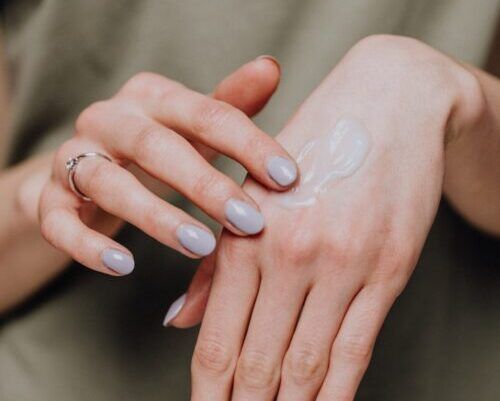
Consider moisturizers with ceramides for aging skin
Healthy, hydrated skin does not show signs of dryness such as dry spots or skin flakes. Skin hydration depends on the barrier function of the skin’s outer layer (stratum corneum). Lipids (fats) in this outer layer help control the loss of water from the skin. Ceramides are a key component of skin lipids. They are also used as an active ingredient in various moisturizing lotions and creams.
Background
Traditional skin moisturizers use an occlusive agent such as petrolatum to limit water loss from the skin surface. Humectants, which are water-loving substances like glycerin, are also used to help retain water in skin.
However, for people with aging skin (e.g., 40 years +), traditional moisturizers may not be the best way to maintain hydration. Here’s why—the “brick-and-mortar” structure of the stratum corneum consists of “dead” skin cells (“bricks”) plus “mortar” composed of lipids. If these lipids are impaired, skin dehydrates as water losses through the lipid “mortar” increase.
As you age, levels of ceramides and other lipids decline, and consequently the skin’s barrier function is reduced. Moreover, ceramides also decrease during the winter months when the greatest drying stresses on skin occur (Rogers et al., 1996). The age-related and seasonal changes in lipid levels put seniors at increased risk of experiencing dry skin. Alternative moisturizer formulations attempt to replenish ceramides so that the barrier function is restored.
What are ceramides?
Ceramides make up 50% by weight of the lipids in the stratum corneum and consist of a fatty acid and a sphingoid base. The nomenclature for ceramides used in moisturizers includes an identifier for the type of fatty acid and for its base. Common ceramides found in moisturizers are Ceramide AP, Ceramide NP, and Ceramide EOP. Ceramides together with fatty acids and cholesterol create a lipid matrix that supports the barrier function of skin. Altered ceramide profiles have been associated with skin disorders such as xerosis (dry skin), psoriasis, atopic dermatitis, and pruritus (Li et al., 2020; Sahle et al., 2015).
Moisturizers with ceramides ‐ what I discovered
I have tried several skin-care products with ceramides from brands including CeraVe, Amlactin, Curel, as well as Walgreens. I discovered that these products used occlusives and humectants along with ceramides to enhance skin hydration. This approach appeals to me because I receive the benefits of a traditional moisturizer plus the replenishment of depleted skin lipids.
Summary
Levels of ceramides and other skin lipids decline as you age, which results in impaired barrier function of the skin’s outer layer. To compensate for the loss of lipids, there are a variety of skin-care products that include ceramide lipids as well as traditional moisturizing agents. If you have not already done so, consider trying moisturizers with ceramides to see how your skin responds.
References
Jeong, Sekyoo, Sin Hee Lee, Byeong Deog Park, Yan Wu, George Man, and Mao-Qiang Man. “Comparison of the efficacy of Atopalm® multi-lamellar emulsion cream and Physiogel® intensive cream in improving epidermal permeability barrier in sensitive skin.” Dermatology and therapy 6 (2016): 47-56.
Li, Qingyang, Hui Fang, Erle Dang, and Gang Wang. “The role of ceramides in skin homeostasis and inflammatory skin diseases.” Journal of Dermatological Science 97 (2020): 2-8.
Rogers, J., C. Harding, A. Mayo, J. Banks, and A. Rawlings. “Stratum corneum lipids: the effect of ageing and the seasons.” Archives of dermatological research 288 (1996): 765-770.
Sahle, Fitsum F., Tsige Gebre-Mariam, Bodo Dobner, Johannes Wohlrab, and Reinhard HH Neubert. “Skin diseases associated with the depletion of stratum corneum lipids and stratum corneum lipid substitution therapy.” Skin pharmacology and physiology 28 (2015): 42-55.
